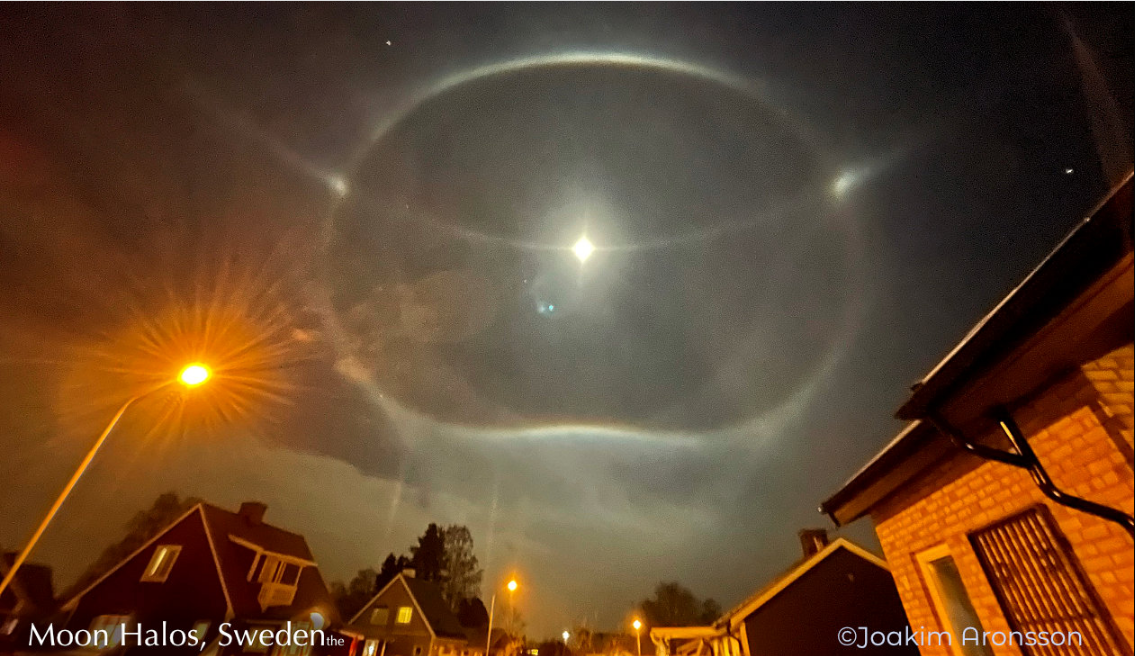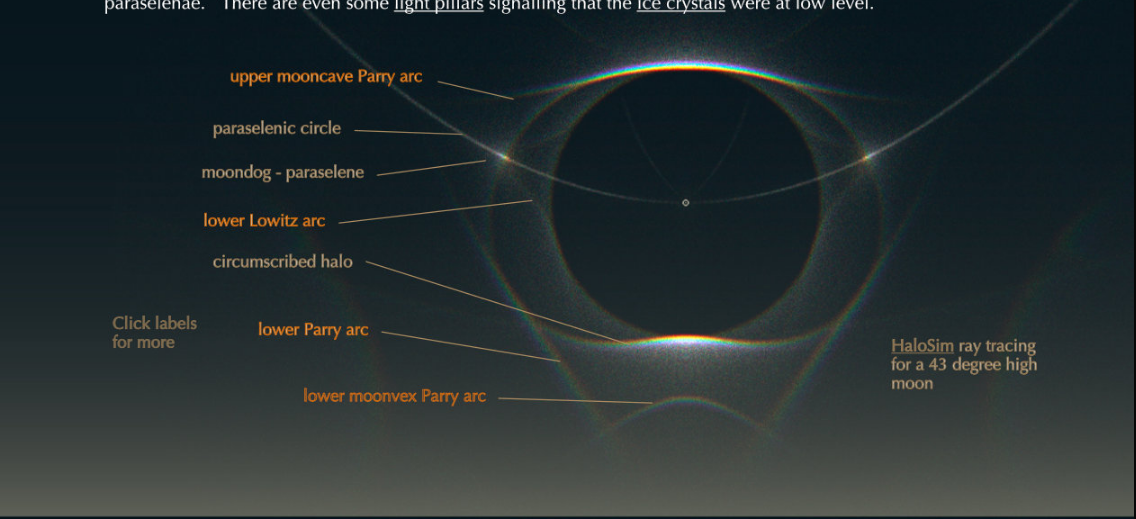Rare moon ice halos Sweden
Rare Moon Ice Halos in Sweden: A Spectacular Display of Atmospheric Optics
Have you ever witnessed a rare lunar ice halo display? On November 29th, 2020, Joakim Aronsson captured a breathtaking sight in Sweden. This stunning phenomenon showcased not only familiar halos like moondogs and the 22-degree halo but also less common ones such as the complete circumscribed halo. However, what truly made this display extraordinary were the presence of rare halos like the upper and lower Parry arcs, lunar Lowitz arcs stretching moonwards from the paraselenae, and even light pillars indicating the presence of low-level ice crystals.
Lunar ice halos occur when light interacts with ice crystals in the atmosphere, resulting in a stunning array of optical phenomena. These halos are caused by the refraction, reflection, and dispersion of light as it passes through the hexagonal ice crystals suspended in the air. As light enters and exits these ice crystals, it bends and separates into its constituent colors, creating a mesmerizing display of colors and shapes.
Let's delve deeper into the specific types of halos observed in this rare moon ice halo display:
-
Moondogs: Moondogs, also known as mock moons or parhelia, are bright spots that appear on either side of the moon. These spots are caused by the refraction of light through horizontally oriented ice crystals. They often have a reddish tinge and mimic the appearance of additional moons.
-
22-Degree Halo: The 22-degree halo is a circular ring of light that forms around the moon. It is caused by the refraction of light through randomly oriented ice crystals in the atmosphere. This halo is named after its approximate radius, which is approximately 22 degrees from the moon's center.
-
Complete Circumscribed Halo: The complete circumscribed halo is a rare phenomenon that forms a complete ring around the moon. It occurs when light undergoes multiple reflections and refractions within the ice crystals, resulting in a full circle of light.
-
Upper and Lower Parry Arcs: Parry arcs are formed when light is refracted through horizontally oriented ice crystals. These arcs appear above and below the moon, intersecting the 22-degree halo. They are named after Sir William Edward Parry, an Arctic explorer who first described these halos.
-
Lunar Lowitz Arcs: Lunar Lowitz arcs are rare and mesmerizing halos that stretch moonwards from the paraselenae. These arcs occur when light passes through vertically oriented ice crystals, resulting in a distinctive arc-shaped display.
-
Light Pillars: Light pillars are vertical columns of light that appear to extend above or below a light source, in this case, the moon. They occur when light reflects off flat ice crystal faces that are oriented horizontally near the Earth's surface. These pillars create a captivating illusion of pillars of light reaching towards the sky.
The occurrence of such a diverse range of lunar ice halos in a single display is truly remarkable. It highlights the complex interplay between atmospheric conditions and ice crystal orientation that contribute to the formation of these optical phenomena. Witnessing such a spectacle reminds us of the beauty and complexity of our atmosphere.
While this particular display was captured in Sweden, lunar ice halos can occur in various locations around the world under specific atmospheric conditions. They often require the presence of high-altitude cirrus clouds, which consist of ice crystals that serve as the necessary medium for these halos to form.
As with any atmospheric optics phenomenon, the best chances of witnessing lunar ice halos are during cold winter nights when the air is calm and free from light pollution. Patience and a keen eye are essential as these displays can be fleeting and require careful observation to fully appreciate their intricate details.
In conclusion, the rare moon ice halo display captured in Sweden on November 29th, 2020, showcased a mesmerizing array of optical phenomena. From the familiar moondogs and 22-degree halo to the less common complete circumscribed halo, upper and lower Parry arcs, lunar Lowitz arcs, and light pillars, this display was a visual feast for the eyes. Such occurrences remind us of the beauty and complexity of atmospheric optics and the wonders that await those who take the time to observe and appreciate the natural world around them. So keep your eyes to the sky, for you never know when the next extraordinary atmospheric display will unfold before your very eyes.

A rare - and beautiful - lunar ice halo display captured in Sweden by Joakim Aronsson on 29th November '20. There are familiar halos like the moondogs and 22 degree halo. Less common ones like the complete circumscribed halo.
Then there are the rare ones like upper and lower Parry arcs and even lunar Lowitz arcs stretching moonwards from the paraselenae. There are even some light pillars signalling that the ice crystals were at low level.

Note: this article has been automatically converted from the old site and may not appear as intended. You can find the original article here.
Reference Atmospheric Optics
If you use any of the definitions, information, or data presented on Atmospheric Optics, please copy the link or reference below to properly credit us as the reference source. Thank you!
-
<a href="https://atoptics.co.uk/blog/rare-moon-ice-halos-sweden/">Rare moon ice halos Sweden</a>
-
"Rare moon ice halos Sweden". Atmospheric Optics. Accessed on November 21, 2024. https://atoptics.co.uk/blog/rare-moon-ice-halos-sweden/.
-
"Rare moon ice halos Sweden". Atmospheric Optics, https://atoptics.co.uk/blog/rare-moon-ice-halos-sweden/. Accessed 21 November, 2024
-
Rare moon ice halos Sweden. Atmospheric Optics. Retrieved from https://atoptics.co.uk/blog/rare-moon-ice-halos-sweden/.